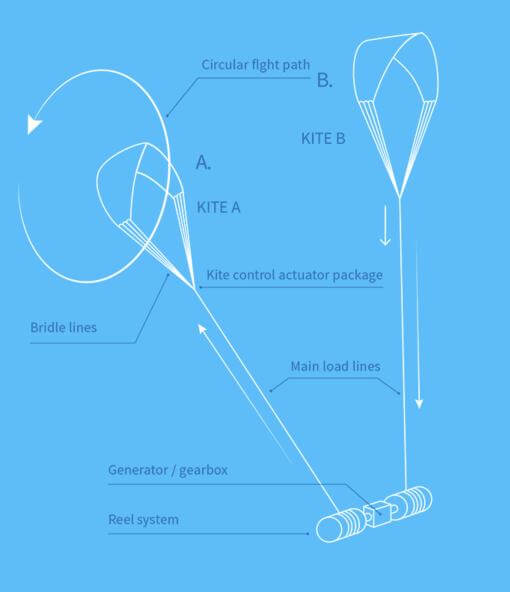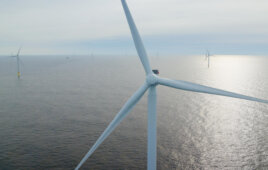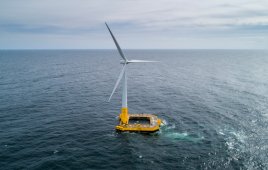Renewable energy consultancy, Natural Power, has secured what is believed to be the world’s first planning consent for a kite power technology test and development site. The application was made on behalf of Kite Power Solutions (KPS) for the test and development site to be located within the MoD West Freugh Range, operated by QinetiQ on behalf of MoD, near Stranraer in Dumfries and Galloway, Scotland.

In the two kite system, while one deploys (A) generating power, it pull in the other, which is in a non-flight status.
Founded in 2011, KPS was established to develop a deep water wind energy technology that can be deployed anywhere in the world at a cost that is able to compete with the lowest cost fossil fuel energy systems.
KPS has already designed, built and demonstrated a 40 kW proof of concept system, regularly flying at its current base, Bradwell-On-Sea Airfield in Essex. A 500 kW pre-commercial demonstration system has also been designed. Once the company has secured the required £5.5 million investment, the next phase of development will commence, and this includes relocation to the West Freugh site which already has ‘controlled airspace’ status, and will enable testing of the kites at heights up to 500m. By 2021 KPS intends to have its 500-kW system available for commercial sale, and will have deployed a floating 3-MW system.
The West Freugh location was selected after extensive consultation with the Civil Aviation Authority. A rolling five year lease for the demonstration test site was signed in February 2016, with first kite system flying on the site expected in April 2017.
Oil major Royal Dutch Shell and the UK’s Department of Energy and Climate Change (DECC) have supported the £3 million development so far. In February 2016, a KPS led consortium was awarded a £1M InnovateUK Energy Catalyst grant towards the test site within MoD West Freugh Range.
Euan Hutchison, Natural Power’s Principal Consultant – Planning and Environment Services, said: “This is an exciting and innovative technology, which has the potential to bring significant community benefits to the area, including employment and investment, as a key local business, we welcome supporting KPS on this innovative project with our industry leading expertise”..
“Our locally based ecologists are already on the ground at West Freugh to determine a plan of action for understanding, assessing and mitigating any specific risks to local wildlife, and we are keen to engage with local stakeholders to help bring this exciting development to fruition.”
Natural Power and KPS attended and presented at the biannual West Freugh conservation group meeting last week. Usual attendees including MoD and Qinetiq Conservation, forestry and deer managers, Scottish Natural Heritage, RSPB, Dumfries and Galloway Council archaeologists and local ecological enthusiasts, discuss progress on the sites conservation objectives.
KPS currently employs a team of ten skilled technology development professionals including experts in aeronautics, neural network software, mechanical engineers, atmospheric physics and sail makers, and this is expected to increase to 19 by the end of 2016, and further to 39 by 2018.
David Ainsworth, Business Development Director, at KPS said: “With Natural Power’s extensive experience in the wind energy sector and its demonstrated ability to support other innovative renewable energy technologies, Natural Power was the obvious choice to support us with the West Freugh project. So far we have been overwhelmed by the warm reception we have received for our plans in Dumfries and Galloway. The whole team is looking forward to relocating to this beautiful area of Scotland and developing this world changing technology in this tremendous environment.”
KPS – how it works
The ambition is to harvest the strong, reliable winds found offshore by tethering two kites to each mooring to capture the wind. Each kite flies in a figure of eight, drawing out the tether and generating power at the winch. When it has reached its maximum height – likely to be 450m – the kite switches to a hover-like mode, where there is little stress on the tether and it can be winched back in ready for the next run, using just a fraction of the power already generated.
Power is delivered continuously because one kite is generating as the other is winched in. Ultimately, the plan is to have scores of kites flying in formation, all automatically controlled using custom-made software.
The kites at full-scale will be 40m wide with 2 to 3-MW capacity, about the same as a 100-m tall conventional turbine. So far, KPS have tested prototypes of 7-m span rated at 40 kW.
Filed Under: Offshore wind




